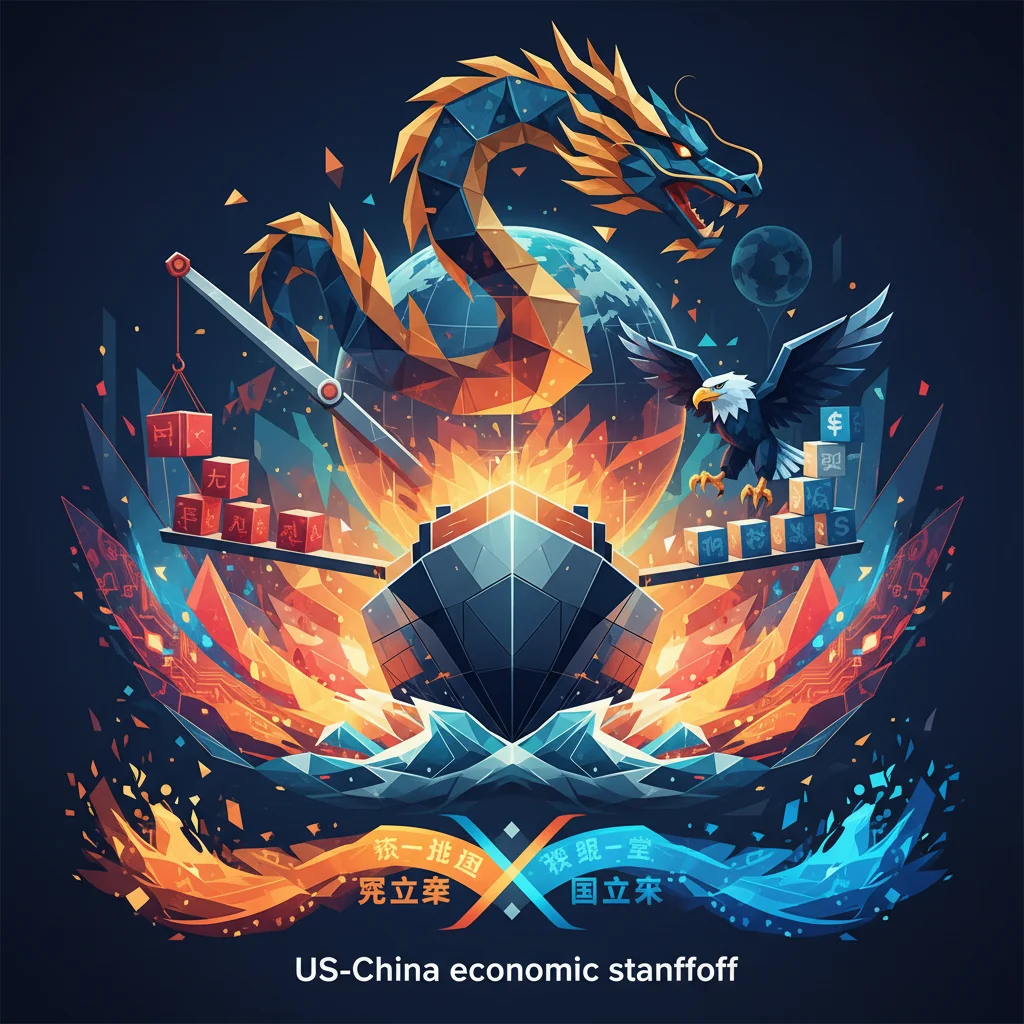
High-Stakes on the High Seas: China’s New Port Fees Signal a New Wave in the US-China Economic Standoff
In the intricate dance of global economics, even the smallest steps can signal a dramatic shift in direction. The latest move comes from Beijing, which has announced it will begin levying new fees on US-linked ships. This decision, as reported by the BBC, is a direct and calculated response to a similar measure from Washington, set to take effect on October 14th against Chinese vessels. While on the surface this may seem like a minor administrative squabble over port duties, it represents a significant escalation in the ongoing economic friction between the world’s two largest economies. For investors, business leaders, and anyone attuned to the rhythms of the global economy, this is not just a headline—it’s a critical signal of rising geopolitical risk and its tangible impact on the arteries of world trade.
This tit-for-tat measure moves the battleground from tariffs on goods to the very logistics that underpin global commerce. It’s a strategic maneuver that threatens to snarl supply chains, increase costs, and inject a fresh dose of uncertainty into an already volatile stock market. Understanding the implications of this development requires looking beyond the immediate news and examining the historical context, the potential economic ripple effects, and the strategic underpinnings of this new front in US-China relations.
The Anatomy of a Retaliation: More Than Just a Fee
At its core, China’s action is a classic example of reciprocity in international relations. The United States, through its Federal Maritime Commission (FMC), has been scrutinizing what it perceives as unfair trade practices within China’s shipping industry. A 2022 FMC report highlighted allegations that Chinese state-owned carriers were receiving unfair state subsidies, giving them a competitive advantage. This led to the US plan to impose fees, framed as a measure to level the playing field. Beijing’s response is a clear message: any economic pressure applied by Washington will be met in kind.
This is not a blanket tariff on all goods, but a targeted levy on the vessels themselves. This distinction is crucial. By targeting the logistics infrastructure, both nations are increasing the fundamental cost of doing business with one another. These fees will likely be passed down the line—from the shipping companies to the importers, from the importers to the retailers, and ultimately, from the retailers to the consumer. It’s a move that directly impacts the mechanics of global trading, making the physical act of moving goods across the Pacific more expensive and complex.
A Lingering Echo: The Unfinished Business of the Trade War
To fully grasp the significance of these new shipping fees, we must view them through the lens of the US-China trade war that began in earnest in 2018. That conflict saw the imposition of hundreds of billions of dollars in tariffs, disrupting industries from agriculture to technology. While the rhetoric has softened since its peak, the underlying tensions and many of the tariffs have remained in place, fundamentally reshaping global supply chains.
The current escalation demonstrates that the core conflict is far from resolved. It has simply evolved. The focus is shifting from finished goods to the critical infrastructure and technologies that power the modern economy. This includes semiconductors, financial technology (fintech), and now, maritime logistics.
To illustrate the progression of this economic friction, consider the key milestones in this ongoing dispute:
| Year | Key Event / Policy Action | Primary Sector(s) Impacted |
|---|---|---|
| 2018 | US imposes sweeping tariffs on over $250 billion of Chinese goods, citing intellectual property theft. China retaliates with its own tariffs. | Manufacturing, Agriculture, Technology Hardware |
| 2020 | “Phase One” trade deal signed, pausing further tariff escalation but leaving most existing tariffs in place. | Financial Services, Agriculture (purchase commitments) |
| 2022 | US passes the CHIPS and Science Act, aiming to boost domestic semiconductor production and limit technology transfers to China. | Semiconductors, Advanced Technology |
| 2024 | US and China implement retaliatory fees on each other’s shipping vessels, targeting logistics infrastructure. | Maritime Shipping, Global Supply Chains |
As the table shows, the conflict has become more targeted and strategic. The latest move into shipping logistics indicates a new willingness to disrupt the foundational elements of trade, a development that should be of prime concern to anyone involved in international finance and commerce.
The Ripple Effect: From Crowded Ports to Your Portfolio
The immediate consequence of these fees is an increase in operational costs for shipping lines. A container ship’s voyage across the Pacific can already cost millions, and these new fees, while perhaps small in percentage terms, add to a mountain of expenses that includes fuel, labor, and insurance. The question for business leaders and those focused on investing is: who absorbs this cost?
- For Corporations: Companies heavily reliant on trans-Pacific shipping will face a difficult choice: absorb the higher costs and accept thinner profit margins, or pass them on to customers. This will be a major point of discussion in upcoming quarterly earnings calls for retail, manufacturing, and logistics companies.
- For the Global Economy: On a macroeconomic level, these fees are inherently inflationary. The Congressional Budget Office has previously noted that tariffs from the trade war contributed to higher consumer prices and reduced U.S. GDP. Adding costs to shipping, the lifeblood of global trade, will only exacerbate these pressures at a time when central banks are struggling to contain inflation. This is a crucial data point for anyone studying economics and its real-world impact.
– For Investors: The stock market is likely to react with increased volatility in specific sectors. Shipping and logistics stocks (e.g., ZIM Integrated Shipping, Maersk) may face headwinds. Conversely, companies that are part of a domestic or diversified “China plus one” supply chain may be seen as safer bets. This event underscores the growing importance of analyzing a company’s supply chain vulnerability as part of any sound investing strategy.
The Strategic Long Game: Decoupling, Technology, and the New Economic Order
These shipping fees are a single battle in a much larger war for economic and technological supremacy. The overarching trend is one of strategic decoupling, where both the US and China are actively working to reduce their mutual dependence in critical sectors. This is driven by national security concerns and a desire to control the technologies of the future.
The competition extends far beyond manufacturing and logistics. It is fiercely contested in areas like:
- Semiconductors: The chokepoint of the modern digital world.
- Artificial Intelligence: The engine of future economic growth and military capability.
- Financial Technology (Fintech): The race to define the future of money, payments, and banking, with China’s development of the digital yuan (e-CNY) being a key initiative to challenge the dominance of the US dollar. Some analysts believe blockchain technology will be a key battleground here.
For businesses and investors, navigating this new reality requires a paradigm shift. The era of frictionless globalization, which defined the post-Cold War world, is over. The new era is characterized by regionalization, supply chain redundancy, and a heightened awareness of geopolitical risk. According to a 2023 survey by the U.S. Chamber of Commerce in China, a growing number of American companies are already de-risking their supply chains away from the mainland in response to these persistent tensions.
Conclusion: Navigating the Choppy Waters Ahead
China’s decision to retaliate with fees on US ships is far more than a procedural trade dispute. It is a deliberate and symbolic move that signals a hardening of economic postures and a willingness to disrupt the very flow of global trade to achieve strategic aims. It reinforces the reality that the US-China economic relationship will be defined by competition and friction for the foreseeable future.
For those in finance, business, and investing, the key is to move from a reactive to a proactive stance. This means stress-testing supply chains, diversifying geographic exposure, and integrating sophisticated geopolitical risk analysis into every major decision. The calm seas of post-war globalization have given way to choppier waters. The latest salvos in the port fee dispute are a clear sign that all hands need to be on deck, prepared to navigate the challenges and opportunities of a more fragmented and competitive world economy.


